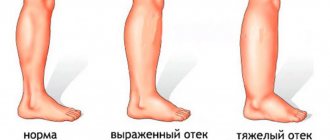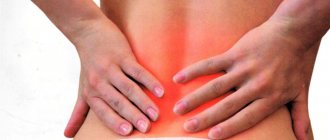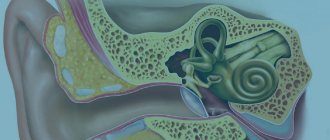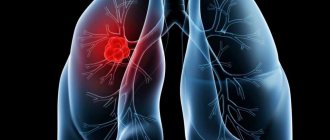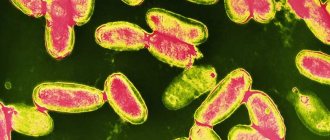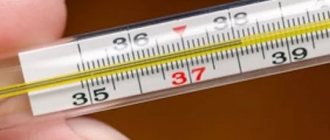Many parents know what intestinal colic in babies is, since it is a fairly common occurrence in children in the first months of life, when their immature digestive system is just beginning to adapt to a new diet. During this difficult period for the baby, every mother should know how to eliminate such an unpleasant and painful symptom at home.
The baby is crying
What is colic and why does it appear?
The first 2 weeks after the birth of a baby are one of the calmest periods in a mother’s life; the baby cries only from hunger, the rest of the time he sleeps peacefully. But after 15-20 days, the nightmare begins - the baby constantly starts crying, eats worse, sleeps poorly - he is bothered by colic.
Colic is not a disease; it occurs in absolutely healthy children; boys suffer from this problem a little more often. The problem arises against the background of increased gas formation in the baby’s intestines - this is how the body begins to adapt to the process of swallowing and digesting food, the process does not always go smoothly.
The main causes of colic
- Incorrect attachment to the breast - if the baby swallows a lot of air while sucking, it will accumulate in the stomach and distend it. If your child is your firstborn, do not hesitate to ask the midwives at the maternity hospital for help so that they can tell you all the intricacies of proper feeding.
- Insufficient lactase - this enzyme is necessary for the normal digestion of lactose, which is found in all dairy products. It is difficult to deal with such a problem; most likely, the doctor will prescribe enzymes or advise you to switch to artificial feeding - there are many good lactose-free mixtures. But such a pathology occurs in only 1 baby out of 130 thousand newborns.
- Wrong diet of the mother - it’s not for nothing that breastfeeding experts insist on following a diet in the first months after the birth of the child; everything you eat goes with the milk into the baby’s intestines. The main provocateurs of increased gas formation in a baby are cabbage, legumes, fruits, milk, rye and bran bread.
- Frequent crying - when the baby sobs, he swallows a lot of air, which provokes the appearance of colic and hiccups.
- Overfeeding, being in a horizontal position for a long time - from birth you need to control the amount of food the child consumes, try to maintain a daily routine, and do not forget about physical activity, according to age.
Since increased gas formation can bother the baby for several months, every mother needs to know not only the symptoms of colic in a newborn, but also treatment methods.
Diagnostics
The primary stage of the examination begins with the fact that the local pediatrician, with whom the child is registered and periodically observed, performs palpation of the abdomen, identifying possible foci of the painful condition of the internal organs. Then a series of tests and the following diagnostic procedures are prescribed:
- blood from a finger (donated to determine blood sugar levels, the percentage of main blood cells - red blood cells, platelets, leukocytes, phagocytes, lymphocytes, which take an active part in the metabolic processes occurring in the child’s body);
- morning urine (it is collected on an empty stomach in the first minutes when the baby wakes up from sleep, and the intended purpose of this analysis is to determine the biochemical composition of urine);
- Ultrasound of the abdominal organs, paying special attention to the abdominal area, where, according to the child’s complaints, the pain syndrome is most pronounced (first of all, the factor of the possible presence of diffuse changes in the tissues of the stomach, liver, intestines, pancreas, duodenum is studied);
- bacterial seeding of stool, which is placed in a sterile container specially designed for this purpose, and the biological sample is immediately transferred to the laboratory for research and identification of a possible imbalance of beneficial and pathogenic microflora;
- a smear from the anal area to rule out helminthiasis in the child, since a large accumulation of parasitic life forms in one place of the gastrointestinal tract can cause blockage in the movement of feces and, accordingly, the further appearance of colic.
Diagnostic procedures such as MRI and biochemical analysis of venous blood, or x-ray of the peritoneum, are used only in extreme cases, if the use of the above methods failed to detect the cause of the pathology.
Symptoms of colic in a newborn
It is easy to recognize an attack of colic; it proceeds approximately the same in all children.
How to understand that a newborn has colic - the main symptoms
- the child becomes restless, especially during feeding, or a few minutes after it ends;
- the baby often cries, moves, knocks his legs, presses them to his stomach;
- the face becomes red;
- the stomach is swollen, hard to the touch, the navel protrudes, there may be a slight arch in the back;
- sleep quality deteriorates;
- the child calms down a little only in his arms;
- The stool may become green, and sometimes constipation occurs.
Feeding a baby who suffers from colic is a difficult task - the baby constantly squirms, throws the breast or spits out the pacifier, gets tired quickly, and does not eat enough. The situation is aggravated by the condition of the mother, who begins to get nervous from powerlessness and confusion, and babies feel this very well.
As soon as the attack passes, the stomach becomes soft, the baby calms down and immediately falls asleep. How long does colic last? Typically, in newborns, an attack lasts 1.5-2 hours and begins approximately 25 minutes after the end of feeding.
Video: how to help a child with colic?
https://youtu.be/4yGQuMy2V0U
Hello girls! Today I will tell you how I managed to get in shape, lose 20 kilograms, and finally get rid of the terrible complexes of fat people. I hope you find the information useful!
Do you want to be the first to read our materials? Subscribe to our telegram channel
Educational games for children from 2 to 10 years old.
Good article, it is very useful for new mothers, and I went through the same thing. In our case, I gave ESPUMIZAN, BOBOTIK, PEDI WATER and did the above methods - it helped us!
Colic has been our problem since birth, from the first week. Suddenly everyone appeared and was here. The baby is suffering, suffering. On the advice of doctors, we do massage - it helps. I don't want to give you pills. We haven’t tried the heating pad yet either. I’ll exclude cabbage from my diet, reconsider the feeding process, maybe he’s actually swallowing a lot of air? Thank you for the article. This topic is very relevant for us now. I hope that together we can solve it.
And I, the eldest, inserted a special tube into her butt (sold at the pharmacy) so that the gas would drain away. It helped a lot! And no pills are needed...
What to do if your child does not sleep normally during the day
The most interesting thing is that colic is common in both girls and boys. And I only realized this when Masha was born! What a tame child, we cried for about a month, nothing helped!! But then everything passed, and we began to smile often!
The article is excellent. You just need to clarify the massage technique so as not to overindulge. Both simethicone and drugs containing it are allergic. Canceled - the allergy went away. Don't rush to change the mixture. Only after the analysis, ask your doctors to prescribe tests. Health to everyone!
But water and massage help us with colic. The article is very useful, thank you! I had my doubts about tea, but now we’ll try it too! Thanks a lot!!
Everyone has a different reaction to simethicone. I gave it to my son, and now I give it to my daughter. Depends on the manufacturer because allergies can occur to additives and not to simethicone itself. And they are all different. We went through this with our son. Not an allergy, but it didn’t fit, that’s all. So far we have found ours. I gave and continue to give. They don't have any allergies. My daughter is already two and a half months old and has had terrible colic almost since birth. A massage and a gas tube are all you need; a bath helps, but it’s not the same without a bobot. My son and I survived colic by the age of three months. I hope it won’t take longer with my daughter.
How to help your baby - effective methods of dealing with colic
My baby has colic, what should I do?
Let me start with the bad news: no medications have yet been invented to treat colic, since this process is physiological and goes away on its own.
But there is also a good one - every mother can alleviate the baby’s suffering; it is enough to exclude all factors that provoke an attack.
How to rid your baby of colic
- Correctly attach the baby to the breast - not only the nipple, but also the alveolus should be in the mouth.
- If the baby is bottle-fed, the bottle should be held at an angle of 45 degrees so that air collects at the bottom.
- 5-10 minutes before each feeding, place the baby on his tummy.
- Carefully monitor your diet.
- Check your child's lactase level; for this you need to take tests.
- Immediately after feeding the baby should not be placed down; you need to hold him horizontally for about ten minutes.
- Try to immediately calm the baby so that he does not cry for a long time.
- If the attack occurs at night, apply a film ironed with a hot iron to the baby's tummy.
- Gymnastics. It is enough to gently bend the baby’s legs towards the tummy several times to release excess gases from the intestines.
https://youtu.be/jxWVS7MY84Q
Menu for a nursing mother
What to eat for a mother with colic in a baby:
- Cow's milk and other dairy products should be introduced into a nursing mother's menu very carefully, carefully monitoring the child's body's reaction, since allergies may occur to them.
- Hard cheeses, as well as cottage cheese, can be eaten absolutely calmly: they contain a lot of calcium, which would be most appropriate during lactation.
- Don’t forget to eat meat, giving preference to lean varieties (poultry, veal, beef). It is better to steam or boil the meat. It is also worth cooking fish.
- Oatmeal is good for digestion.
- Mom can safely eat dried fruits. Prunes and dried apricots will bring tangible benefits to the body.
- Be sure to include drinks in your diet. Sugar-free compotes, rosehip decoction, green tea, and water are suitable for consumption.
Prevention of intestinal colic
A newborn has a tummy ache - how to help
If a child has colic, what should parents do to prevent it and how to treat it:
- Do not overfeed. Even an extra spoonful of milk in the stomach can cause bloating and gas.
- Do not overheat. Newborns have imperfect thermoregulation; it is very easy to overheat them. It is necessary to ventilate the room as often as possible, arrange wet cleaning - all this will help improve metabolism and save the baby from stomach problems.
- Apply correctly to the breast. A loosely grasped nipple and rapid sucking cause the swallowing of excess air.
- Choose the right pacifier and bottle. You can buy anti-colic bottles at the pharmacy that prevent you from swallowing excess air during feeding.
- Choose a suitable mixture. Some babies are not suitable for formula milk due to a reaction to the protein. Changing formula can also cause colic and digestive disorders in newborns. Switching to another mixture is a long and gradual process.
- Place the baby on the tummy. The muscles of the neck and back will become stronger over time, and gas and pain will decrease.
- Hold the baby on your tummy in different positions.
- A nursing mother needs to understand that her diet is the key to the child’s peace of mind.
Note! If your baby's colic does not go away after four months, you should consult a doctor.
What to eat to avoid colic
Diet for a nursing mother to prevent her baby from having colic:
- Natural fermented milk products, such as kefir (2.5%), yogurt without additives, sour cream 15% fat.
- Sources of calcium include hard yellow cheese, sesame seeds, green leafy vegetables, and dried figs.
- Sources of protein are sea fish, lean meats.
- Sources of dietary fiber are vegetables and fruits, greens. It is better to bake apples and pears in the oven or peel them.
- Nursing mothers can eat all dried fruits, except raisins, preserves and jams, natural marshmallows, marshmallows and marmalade. Everything in moderation.
Should I breastfeed if I have colic?
What is colic in infants, and is it worth feeding breast milk during colic? Sucking distracts and soothes the newborn, but at the same time can increase intestinal pain. If a mother notices intestinal spasms in her baby, she needs to monitor whether she has organized the breastfeeding process correctly. The baby can drink breast milk for as long as he wants. His body is still very weak, and his stomach volume is small, so he wants to eat all the time.
How to get rid of colic in newborns while breastfeeding? If your baby experiences bloating, diarrhea, and belching, you need to hold him in an upright position for 10-15 minutes until excess air escapes or the baby burps. It is also important to adhere to the feeding schedule. You need to feed the baby no more often than every 2.5 hours, this is necessary so that the milk is well digested. If during each feeding the baby is bothered by cramps in the tummy, you need to take short breaks. If there is excess gas in the stomach, you can lightly stroke the baby's tummy.
Additional Information. Under no circumstances should you stop breastfeeding and switch to formula. Breast milk contains a lot of nutrients, minerals and vitamins that the baby needs for proper development.
Intestinal pain in a newborn baby is common. You can significantly alleviate the baby’s condition if you know what colic is in newborns, the reasons for its occurrence, monitor the diet, massage the baby’s tummy and do gymnastics.
https://youtu.be/F7L0MtS2ZxY
Anti-colic massage
You need to do it when the tummy becomes a little soft, otherwise you will only increase the manifestation of unpleasant sensations. Massage your baby about 40 minutes after feeding.
Wash your hands, rub them a little to make them warm, and place the baby on his back. Use light circular movements to stroke the belly around the navel; the liver area should not be touched; you need to move clockwise. Then you can increase the pressure a little and continue the session for 2-3 minutes.
Perhaps these measures will not help completely eliminate colic, but the attacks will become less pronounced and will not cause as much anxiety to you and the baby.
Symptoms and clinical manifestations
Signs of intestinal colic in children are divided into two groups:
- Infantile colic occurs mainly in children under 8 months of age. Severe pain appears either immediately after feeding or 15-30 minutes after it. The baby becomes restless, cries a lot, twists his legs, strains, but the passage of feces or gases does not occur. When palpating the abdomen, excessive tension in the anterior abdominal wall is felt. The condition is considered normal. Colic usually goes away with massage or use of a gas tube.
- Pathological colic can occur in children of any age. Unlike infants, they have a slightly different clinical picture. An attack of pain begins suddenly at any time of the day (it all depends on the root cause that caused it). Pain is localized in the lower abdomen or covers the entire abdominal cavity. Painful attacks occur sporadically. Over time, they may become stronger and have shorter periods of rest.
If you suspect an intestinal obstruction, you should immediately call for medical help.
If intestinal colic develops against the background of any diseases, they always have additional symptoms:
- High body temperature – if the cause is a viral infection, then the condition is complemented by a cough, runny nose, and sore throat. In cases where the temperature rises due to an intestinal infection, it rises to 40 0 C. When taking antipyretics, it quickly returns to its previous level.
- Bloating – occurs when stool is difficult to move through the intestinal ducts, causing severe gas formation. The cause may be disturbances in the functioning of internal organs, various obstacles in the intestinal ducts, or their torsion.
- Nausea and vomiting can result from muscle spasms due to an intestinal infection or disturbances in the functioning of the digestive tract.
- Stool disorders are a characteristic symptom of intestinal colic, which accompanies numerous pathological phenomena in the body. At the same time, even a baby may experience both severe constipation and frequent diarrhea mixed with mucus or blood.
- Loss of strength and headaches are common with colic that occurs due to food poisoning, intestinal infections and intestinal obstruction.
If intestinal colic in children does not go away for a long time (2-3 hours or more), and his condition quickly worsens, complicated by vomiting, fever, loose stools, or, conversely, severe constipation, you should immediately seek emergency medical help.
Colic in a small child is spasms of the gastrointestinal tract, which arose due to the presence of inflammation of their mucous membrane or denser epithelial tissues. The reasons for such a pathological condition of the baby’s abdominal cavity can be factors of nutrition, lifestyle, hereditary predisposition, or the disease is triggered by an imbalance between beneficial and pathogenic microflora. Typically, colic does not act as an independent disease, but is only a symptom of it. Most often, this sign of intestinal dysfunction is diagnosed in children whose age ranges from 1 to 5 years. Intestinal colic in school-age children also occurs quite often and is mainly associated with the lack of a normal diet and long breaks between meals.
What to do if nothing helps
If colic greatly bothers your baby and prevents either him or you from sleeping peacefully, you can resort to pharmaceutical or folk remedies, the action of which is aimed at reducing gases in the intestines. If the problem is caused by poor protein breakdown, enzymes are prescribed.
Effective means:
- Simethicone, Espumisan, Bobotik - these medications contain the substance simethicone, which turns gas bubbles into liquid, the pressure on the intestinal walls decreases;
- enzymes – Mezim, Lactazar, Creon;
- medicines based on herbal components - Bebinos, Plantex.
Dill water is good for colic; you can buy it at the pharmacy or prepare it yourself.
Recipe for proper dill water
Grind 1 tsp in a coffee grinder. fennel seeds, you can also take dill seeds, but their therapeutic effect is somewhat weaker. Pour 200 ml of boiling water over the powder, simmer the mixture in a steam bath for a quarter of an hour. Strain, add warm water to the initial volume.
There is another option. Pour 1 tsp into a thermos. crushed fennel seeds, brew a glass of boiling water, leave for half an hour, the seeds do not need to be crushed, but then the infusion time should be increased to 1 hour.
Dill water can be given to a child from the second week of life - 5 ml before meals three times a day. If the drink turns out to be very sugary, you can dilute it with a small amount of milk, or add it directly to the bottle with the mixture.
Herbal medicine against spasms
Harmless treatment of intestinal colic can be carried out using folk remedies (after consultation with a specialist). If the spasm is accompanied by constipation, decoctions obtained from herbal infusions with anise fruits, elderberry flowers, buckthorn or licorice bark will help to relax the intestines and speed up bowel movements.
To suppress fermentation and putrefactive processes, treatment is carried out by combining herbs. Bird cherry, oak bark and alder cones are simmered in a water bath and the child is given the decoction to drink in small sips throughout the day (daily dosage – 250 ml).
Immortelle flowers, sage, blueberries, cinquefoil root and caraway have astringent effects. All ingredients are poured with boiling water and after infusion, given to the child for treatment. You need to drink the drug 3 times. per day before meals, 100 ml.
- If your child periodically experiences intestinal colic, try to eliminate it by adjusting his diet. Exclude from the children's diet seasonings, soda, dishes made from yeast dough, pickles, marinades, everything fatty and fried, as well as foods with coarse fiber (diet No. 4).
- Prevention of intestinal disorders in a child includes a light massage of the abdomen and back, physical activity, compliance with dietary standards, drinking tea with mint, fennel, and chamomile.
Timely treatment of intestinal colic promises a favorable prognosis. Advanced conditions are dangerous due to dysbiosis, irritable bowel syndrome, enterocolitis and other pathologies.
https://youtu.be/wi0r9EnOg4s
Intestinal colic in children is a common disorder of the digestive tract. Both adults and children suffer from this disease. Any parent has encountered the complaint that a child has a pain in the abdomen, and the pain is sharp, strong, and there is a feeling of fullness.
A baby's life consists of two activities: sleeping and eating. And the first month passes calmly. But after this time, the newborn’s tummy begins to ache, and the first colic appears. The baby is restless and constantly cries, which drives adults into despair.
When should you go to the doctor?
If you do everything correctly, and the baby continues to suffer from colic, you need to visit a doctor. Sometimes severe attacks can be caused by problems with the digestive system, which require surgical intervention.
According to Dr. Komarovsky, symptoms of colic in a newborn are normal, treatment lies in parental patience and care. A well-known pediatrician believes that no special therapy is required, all medications are just a ploy for parents who strive to eliminate the baby’s discomfort as quickly as possible. Colic is a physiological problem that disappears on its own when the time comes.
https://youtu.be/yzduvGtrwzo
Signs of acute intestinal colic
Spastic sensations are always acute and are manifested by a burning sensation in the intestinal area and cramping pain. As soon as the child feels better, he should undergo an examination to clarify the diagnosis that provoked the adverse changes.
The following symptoms will help parents make sure that the spasm is truly acute:
- pain occurs suddenly;
- during cramps, the abdominal muscles tense;
- loose, heterogeneous stool with mucus and a foul odor is released;
- Intestinal spasms in children appear periodically and for a short time.
When intestinal colic occurs, the baby's body temperature may remain normal if the discomfort is not associated with an intestinal infection. When the tract becomes infected, the thermometer reaches high levels, and the symptoms of colic resemble a cold in combination with an intestinal disorder.
Treatment of functional pain
A child with functional abdominal pain, unlike a child with organic disease, has normal laboratory tests, including abdominal ultrasound.
Treatment of functional pain is often long-term, in which case it is necessary to evaluate provoking factors (for example, stress), and there is often a need for changes in diet and lifestyle in general. Sometimes the help of a psychologist or psychiatrist can be helpful. The goal of therapy is to reduce the child's stress and tension and return him to normal activities.
Lactase deficiency
Another reason is lactase deficiency. Characterized by a lack of the enzyme lactase, which breaks down the milk sugar lactose. As a result, undigested sugar ferments and causes gas.
Lactase deficiency can cause colic, but is not the root cause of its occurrence in most children, since it is quite rare - approximately 1 case per 100,000 newborns. Lactase deficiency cannot be established by description alone. It is necessary to conduct an examination that will confirm or refute the diagnosis. Subsequently, the child is prescribed the necessary medications in combination with special mixtures, after which the attacks usually go away.
Crying from discomfort
Young mothers get very nervous at the slightest cry of their first child. It seems to them that the little one is suffering very much, since his face is wincing in pain. But is it always clicks?
The newborn's digestive system is going through a stage of adaptation to a new diet and digestion of food; this does not always go smoothly. A small organism is rebuilt sometimes with pain and suffering.
Mom must develop patience, stop panicking and help the baby adapt to new living conditions. The baby may cry simply from uncomfortable sensations in the tummy. He may even scream angrily in indignation at the discomfort in his body. But this is not colic!
Diagnostics at home and in hospital
If colic occurs in the abdomen in a child 7 years of age or older, it is necessary to conduct a comprehensive examination to determine the exact cause of the pathology. Only after this will it be clear what causes the painful symptoms and how to eliminate them. The pediatrician will determine the type of disease and make a primary diagnosis.
To identify the inflammatory process and the presence of anemia, the doctor will prescribe a blood test. An important stage is the coprogram. This is a laboratory test of stool. When diagnosing gastrointestinal diseases, it is mandatory.
Fecal analysis helps determine where the source of pain is: in the intestines, pancreas or liver. Doctors also prescribe a urine test and a number of additional procedures, the list of which may include colonoscopy, ultrasound examination of the abdominal cavity, as well as an FGDS procedure and sigmoidoscopy. An examination using equipment is prescribed to obtain additional information and make an accurate diagnosis.
How to proceed?
In fact, acute illness should never be ruled out when experiencing repeated abdominal pain. These include appendicitis or impaired intestinal patency. Therefore, if the course of problems is characterized by unfavorable deviations, you should definitely consult a doctor.
If a child has a high fever at the same time, an acute illness cannot be ruled out. Often we are talking about inflammation of the gastrointestinal tract. In this case, a gastrointestinal tract examination, diet and an increased amount of fluid are required.
What is important for parental attention?
In connection with diseases of the gastrointestinal tract, it is always important that parents pay attention to the nature of the child’s stomach pain. Does it manifest itself as a feeling of pressure, tingling or spasms, in what places is it localized, do difficulties arise depending on food intake, etc.
A very important factor is the duration of the problems and what helps alleviate the condition. An important indicator is information about the child’s stool, its consistency, the presence of blood, mucus, food debris or parasites. Evidence of recurrent diarrhea or constipation is also very important. Appetite plays an important role - whether it is good or bad.
Inflammation of the mucous membrane of the gastrointestinal tract
Stomach pain also accompanies acute gastroenteritis, a viral or bacterial inflammation of the mucous membrane of the gastrointestinal tract.
After an incubation period (1–7 days, usually 5 days), this disease results in repeated watery bowel movements, possibly containing mucus or blood. Fever and vomiting precede or accompany the disease, but the presence of these symptoms is not a prerequisite.
Stomach pain with fever and diarrhea is more typical of a bacterial intestinal infection. Colic, vomiting, cough with fever, and later with diarrhea, indicate the presence of a viral infection.
Preventive measures
To prevent an attack, try:
- exclude from the baby’s diet potentially harmful and dangerous foods that cause digestive problems;
- carefully create a menu that should consist of high-quality food enriched with nutrients;
- teach children not to eat dry food and on the go, as this can worsen the digestion process and reduce the production of enzymes;
- do not overeat to prevent the formation of heaviness in the stomach;
- include more fermented milk products, cereals, fresh fruits and vegetables, and flaxseed oil in the children's diet.
Only doctors can say exactly what you can eat after a detailed examination. Timely prevention, proper nutrition and taking special medications help prevent many unpleasant consequences and improve the functioning of children's intestines.
https://youtu.be/X9E_5wkywVE
Even children suffer from psychosomatics
If the child sleeps peacefully, the pain does not awaken him from sleep and is localized around the navel, most likely we are talking about the so-called functional abdominal pain, which is related to psychosomatic disorders. They are characterized by continuous or almost continuous abdominal pain (especially during school or adolescence) and are not relieved (or hardly relieved) in the context of physiological functions such as nutrition, menstruation, defecation.
Recurrent stomach pain that disrupts normal activities affects 5% to 15% of school-age children. 90–95% of them do not have an organic disease. These problems include irritable bowel syndrome, which is more common in teenagers and is characterized by alternating constipation and diarrhea with abdominal pain that is relieved by bowel movements. There may be bloating and mucus in the stool.
Another disease, functional dyspepsia, is characterized by recurrent abdominal pain. They are mainly located above the navel, in the upper abdomen, and are associated with meals. This disorder is manifested primarily by bloating, nausea, and belching.
No “grandmother’s recipes”!
If a doctor diagnoses acute gastroenteritis, the diet for intestinal colic that the doctor recommends is important, regardless of the provoking factor. Avoid old recipes such as diet sausages, dark chocolate or ice-cold Coca-Cola!
Ideal for replenishing fluid are special solutions for children, which are advisable to have at home (they can be bought at a pharmacy without a prescription). This is especially important for toddlers or preschool children, as timely rehydration will prevent further damage to the intestinal lining, including stomach pain and diarrhea. Of course, along with rehydration, the correct diet should be introduced - the menu should include rice, pasta, potatoes, bread, carrot soup, applesauce.

